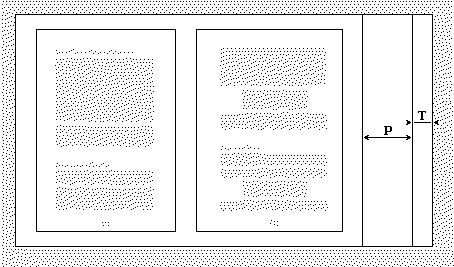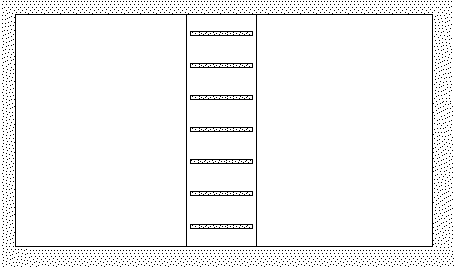
4. Making a Book Cover
Part of
the Bookbinding Tutorial
|
You have a decent book now, on archival paper, and you need a cover that will be reasonably durable. A full hard-backed case binding is a big project, so I'll recommend something less, a long-stitched soft-board binding. This was recommended to me by the book conservation lab at the University of Iowa, and I'm very satisfied by the results I've achieved using it.
I should note that if you have professional bookbinders in the area (and most large cities have them), you should be able to geet your book bound for somewhere on the order of $20. Professionals have machines and supplies to do a case binding on fairly short order.
The cover for a long-stitched binding is made of cardboard -- specifically acid free two ply museum board. Good art-supply stores carry this. One sheet will make about eight book covers for books printed on standard sized typing paper.
In determining the size of the cover, you have to allow for not only the thickness of the paper, but the thickness of the thread used to sew the binding, so now is the time to get the thread. Traditionally, unbleached linen thread is the preferred material, but unbleached long-staple cotton will do almost as well. The key is that it is a natural fiber comparable in expected lifetime to the paper and the cover material, and that it have very long fibers, giving it great strength.
The thread should be heavy, heavy enough that you might be as likely to call it fine cordage as you are to call it heavy thread! Thread diameters of close to a millimeter (when uncompressed and not under tension) are quite reasonable. The thread should compress to about 1/2 millimeter when successive turns are wrapped tightly around a pencil.
If you have 19 sections, as in DEC's 1973 Introduction to Programming, you'll need to add the thickness of 19 threads to the thickness of your book. To find this, wrap 19 turns of thread tightly around a pencil and measure the length of the wrapping, then add this to the thickness of the clamped spine of the stack of sections that will make up your book.
The museum board has the interesting property that it flexes fairly easily in one direction but it is fairly stiff in the other. You want your cover to flex easily from side to side, since that's the way you tend to bend the covers of a book when you hold it open to read. You want the book to be stiff from top to bottom, since bending in that direction should never happen. Taking this into account, cut a rectangle of museum board with the dimensions shown in Figure 4.1:

|
I did all my cutting with a carpenter's square to guide a large X-acto knife. It took two or three scores with the knife to cut all the way through, and I used an old cardboard sheet as backing so I wouldn't cut into the top of the table I was working on. A paper cutting guillotine also works well to cut out the cover, particularly the type of guillotine that clamps the material being cut so that the blade does not pull the cardboard sideways as it cuts.
Having cut out a rectangular piece of cardboard, you need to score the creases where the cover will hinge to wrap around the pages. I measured twice to avoid error, then set my straight-edge along the planned hinge lines and used a blunt tool to score the crease. Traditional bookbinders would use a bone tool for this. I used the rounded and polished end of a metal ruler I found in my toolbox. Be careful not to cut or tear the fibers of the board when you score it; your goal is to compress the fibers in order to guide the crease. Figure 4.2 shows the cover with scored creases.

|
Before you bend the cover, you need to cut a series of equally spaced square-ended slits in the cover, as shown in Figure 4.2. Typically, these should be about an inch apart, (anywhere from 2 to 3 cm will do) and the slits at the top and bottom should be a bit closer to the top and bottom edges of the book (about 1/2 inch or 1.5 cm is nice). Each slit should be about 1 mm wide, but the precise width is less important than the uniformity.
I cut 8 slits for this purpose, but 7 would be just as good. The ends of the slits should be about 1/2 the thickness of one section of your book from the creases that you just scored in the cover.
There are several ways to cut these slits. For my first effort, I used an X-acto knife, but I've found that cutting cardboard with a hammer and chisel is very fast and accurate. Use a broad-bladed wood chisel that's almost the length of the slit you want, and make sure it's very sharp. Place the chisel so the flat side faces the side of the slot you are keeping, and the beveled face faces the waste material you will discard. Always work against a disposable backing that won't damage the chisel; I use some heavy strathmore board for this. Practice a bit on scraps of your cover material before you attack the real thing.
Another way to make these slots was suggested to me by Neil Tyler. He has done this with an inexpensive utility knife, the kind with a cast metal handle that is in two halves held together by a screw. Normally, you put only one blade in such a knife, but if you put two blades in, side by side, with a spacer between them, you can cut slots that are about as wide as the thickness of the spacer plus the thickness of one blade. There is one warning about this method! Be extremely careful! Wounds made by closely spaced parallel blades are nasty, difficult to bandage and slow to heal when compared with the commonplace cuts that most users of sharp tools have experienced on occasion.